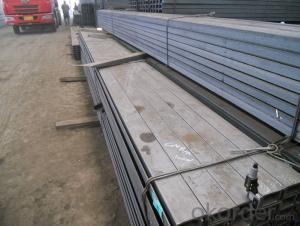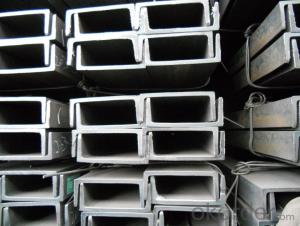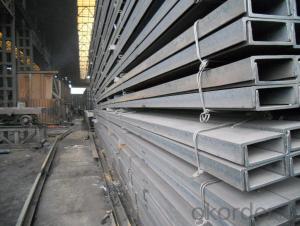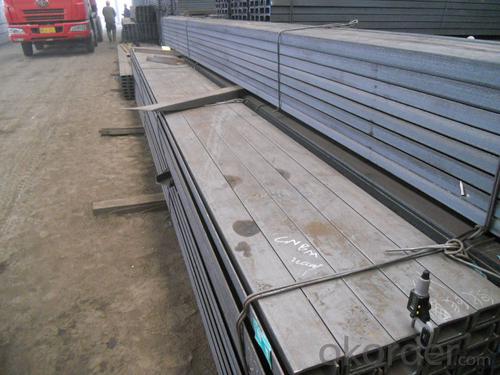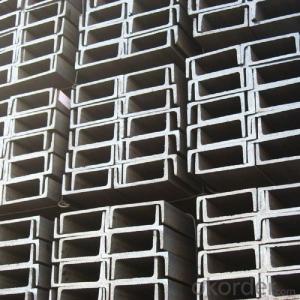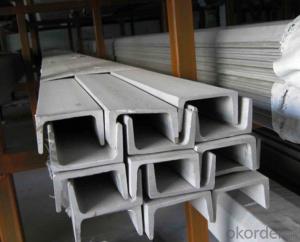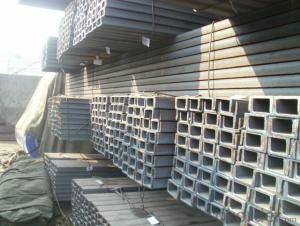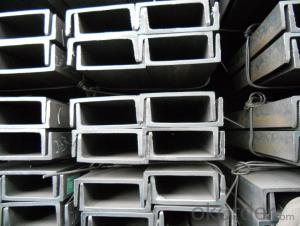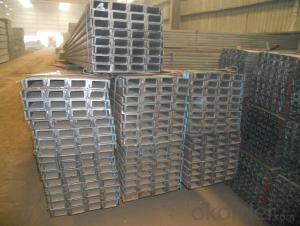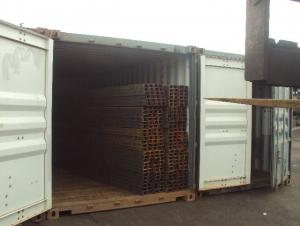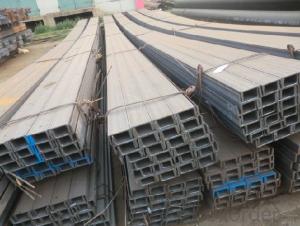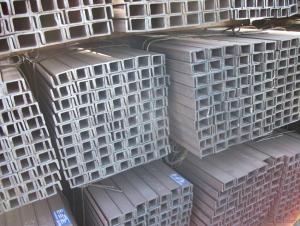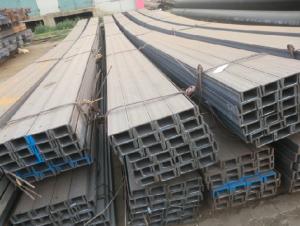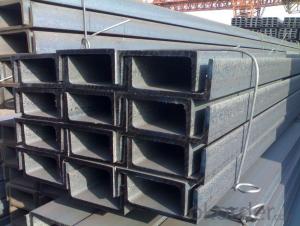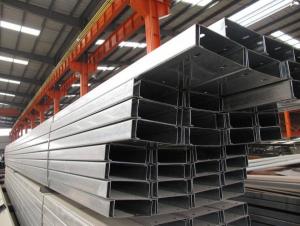Hot Rolled U-channel Carbon Steel JIS Standard Many Sizes
- Loading Port:
- Tianjin
- Payment Terms:
- TT or LC
- Min Order Qty:
- 25 m.t.
- Supply Capability:
- 1000 m.t./month
OKorder Service Pledge
OKorder Financial Service
You Might Also Like
Product Description:
OKorder is offering U-channel at great prices with worldwide shipping. Our supplier is a world-class manufacturer of steel, with our products utilized the world over. OKorder annually supplies products to European, North American and Asian markets. We provide quotations within 24 hours of receiving an inquiry and guarantee competitive prices.
Product Applications:
1.The JIS channel can be devided into two kinds, namely common channel steel and light channel steel. The sizes of hot rolled common channel steel range from 5# to 40#. Meanwhile, the channel steel can be divided into cold forming sectional equal channel steel, cold forming sectional unequal channel steel, cold forming inner edge channel steel and outer edge channel steel.
2.The JIS channel is usually used for arch-itechtural structure, and they could be welded in order to support or hang a vari-ety of facilities. They are also usually used in combination with I beam. The channel steel with sizes under 14# is usually applied to construction engineering, as purline, while the channel steel with sizes above 16# is more likely to be used in building vehicle chassis structure and mechanical structure. Furthermore, the channel steel in sizes above 30# are target at building bridge structure, as tension bar.
Product Advantages:
OKorder's U-channel are durable, strong, and resist corrosion.
Main Product Features:
· Premium quality
· Prompt delivery & seaworthy packing (30 days after receiving deposit)
· Corrosion resistance
· Can be recycled and reused
· Mill test certification
· Professional Service
· Competitive pricing
Product Specifications:
1. We are definitely speciallizing in manufacturing and supplying channel steel as per japanese standard, which is characterised with high mechanical strength and competitive prices.
2. The sections in details are as followings in the table-1
JIS CHANNEL | Standard h | Sectional b | Dimension s | t | Mass: Kg/m |
(mm) | (mm) | (mm) | (mm) | ||
50x25 | 50 | 25 | 3.0 | 6.00 | 2.37 |
75X40 | 75 | 40 | 3.8 | 7.00 | 5.30 |
75X40 | 75 | 40 | 4.0 | 7.00 | 5.60 |
75X40 | 75 | 40 | 4.5 | 7.00 | 5.85 |
75X40 | 75 | 40 | 5.0 | 7.00 | 6.92 |
100X50 | 100 | 50 | 3.8 | 6.00 | 7.30 |
100X50 | 100 | 50 | 4.2 | 6.00 | 8.03 |
100X50 | 100 | 50 | 4.5 | 7.50 | 8.97 |
100X50 | 100 | 50 | 5.0 | 7.50 | 9.36 |
125X65 | 125 | 65 | 5.2 | 6.80 | 11.66 |
125X65 | 125 | 65 | 5.3 | 6.80 | 12.17 |
125X65 | 125 | 65 | 5.5 | 8.00 | 12.91 |
125X65 | 125 | 65 | 6.0 | 8.00 | 13.40 |
150x75 | 150 | 75 | 5.5 | 7.30 | 14.66 |
150x75 | 150 | 75 | 5.7 | 10.00 | 16.71 |
150x75 | 150 | 75 | 6.0 | 10.00 | 17.90 |
150x75 | 150 | 75 | 6.5 | 10.00 | 18.60 |
150x75 | 150 | 75 | 6.5 | 10.00 | 24.00 |
200X80 | 200 | 80 | 7.5 | 11.00 | 24.60 |
Note of U-channel
1. According to national standard (GB) for our products, if not, supply according to national standards (GB) or agreement.
2. We can not only provide electric furnace +LF+VD and electros lag re-melting (ESR) steel forging materials, but also forging products of piece, bar, etc.
3. Our company is equipped with roll equipment and can provide our customers with roll billets or finished.
4. The materials that we purchase are all accord with International General Standard; you could check it out on the Material Quality Sheet.
5. We are the creator of the “seven-step inspect method” in China.
6. The technical workers we employed are the ones with many years’ working experience, who know the technology procedures very well.
7. We will strictly inspect our production that we sold according to the customer’s request.
8. Our steel reaches international quality standards. Besides, our company is equipped with large-sized vertical saw machines, horizontal saw machines, milling machines, grinding machines and other advanced equipment. All our products are carried out hardness tests, such as the ultrasonic flaw detection before shipment. Therefore, there is no quality problem. With more competitive price than other suppliers, our steel has good sales in the markets of North America, South America, East Europe, Southeast Asia, Africa, Oceania, the Middle East, East Asia and West Europe.
FAQ:
Q1: Why buy Materials & Equipment from OKorder.com?
A1: All products offered byOKorder.com are carefully selected from China's most reliable manufacturing enterprises. Through its ISO certifications, OKorder.com adheres to the highest standards and a commitment to supply chain safety and customer satisfaction.
Q2: How do we guarantee the quality of our products?
A2: We have established an advanced quality management system which conducts strict quality tests at every step, from raw materials to the final product. At the same time, we provide extensive follow-up service assurances as required.
Q3: How soon can we receive the product after purchase?
A3: Within three days of placing an order, we will begin production. The specific shipping date is dependent upon international and government factors, but is typically 7 to 10 workdays.
Images:
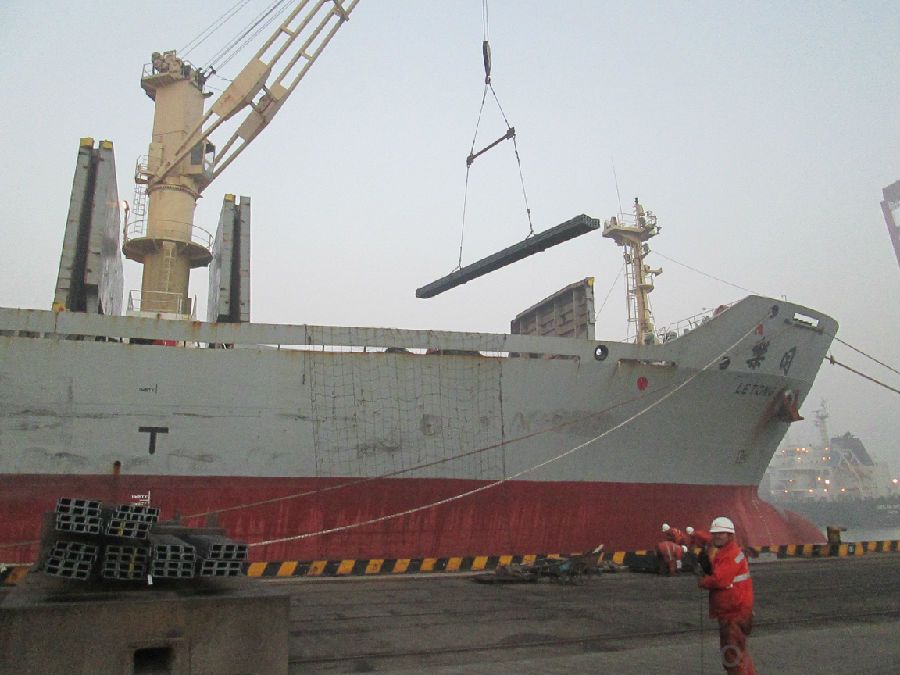
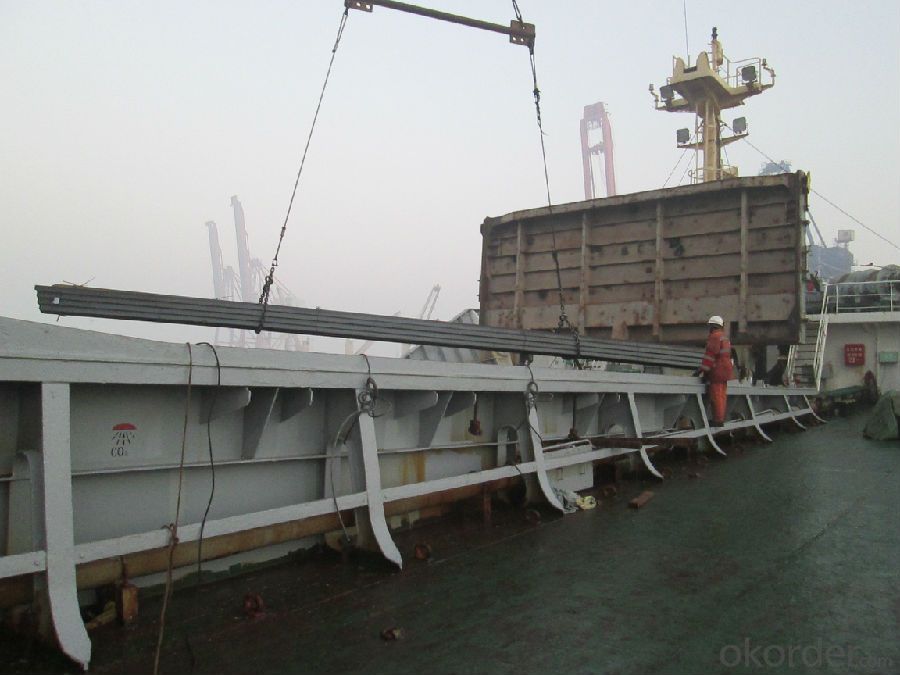
- Q: What are the factors to consider when determining the spacing of steel channels in a structure?
- When determining the spacing of steel channels in a structure, there are several factors that need to be considered. These factors include the load requirements of the structure, the span length of the channels, the material properties of the steel, and the desired deflection limits. Additionally, factors such as construction techniques, available resources, and cost considerations also play a role in determining the spacing of steel channels in a structure.
- Q: Can steel channels be used in earthquake-resistant buildings?
- Yes, steel channels can be used in earthquake-resistant buildings. Steel channels are commonly used in the construction industry due to their high strength and durability. In earthquake-resistant buildings, it is important to have a structural system that can withstand the lateral forces generated during an earthquake. Steel channels can effectively distribute and dissipate these forces, making them a suitable choice for earthquake-resistant construction. Steel channels provide several advantages in earthquake-resistant buildings. Firstly, they have excellent load-bearing capacity, which allows them to support heavy loads and resist the forces exerted during an earthquake. Secondly, they have a high modulus of elasticity, meaning they can deform under stress and then return to their original shape once the stress is removed. This flexibility helps prevent brittle failure and allows the structure to absorb and dissipate energy during an earthquake. Additionally, steel channels have a high ductility, which is crucial in seismic design. Ductility refers to the ability of a material to undergo large deformations without breaking. During an earthquake, steel channels can absorb and dissipate energy by undergoing plastic deformation, reducing the overall damage to the structure. Furthermore, steel channels can be easily fabricated and installed, making them a cost-effective option for earthquake-resistant construction. They are also readily available in the market in various sizes and shapes, allowing for flexibility in design. However, it is important to note that the use of steel channels alone is not sufficient to ensure complete earthquake resistance. The overall structural design, including the connections, bracing systems, and foundation, should be carefully considered and designed by a qualified structural engineer to meet the specific seismic requirements of the region. Building codes and regulations also play a crucial role in ensuring the safety and resilience of earthquake-resistant buildings.
- Q: How do steel channels contribute to the overall design flexibility of a project?
- Steel channels contribute to the overall design flexibility of a project by providing strength, stability, and adaptability. They can be easily shaped, cut, and welded to fit the specific requirements of the project, allowing for various configurations and structural designs. With their high load-bearing capacity, steel channels provide support for heavy loads, enhancing the structural integrity of the project. Additionally, their durability and resistance to corrosion make them ideal for various applications, ensuring long-term reliability and flexibility in design choices.
- Q: Can steel channels be used in airport construction?
- Yes, steel channels can be used in airport construction. Steel channels are commonly used in construction projects due to their strength, durability, and versatility. In airport construction, steel channels can be utilized for various applications such as structural support, framing, and the creation of walkways and platforms. They can also be used for the fabrication of airport equipment and fixtures. Steel channels provide a cost-effective solution for airport construction, as they can be easily fabricated and installed. Additionally, steel channels are resistant to corrosion and can withstand heavy loads, making them suitable for the demanding requirements of airport infrastructure.
- Q: How are steel channels used in the construction of warehouses?
- Steel channels are commonly used in the construction of warehouses due to their strength and versatility. They are typically used to provide support and structural stability to the building. Steel channels are often used as beams or columns to carry heavy loads and distribute the weight evenly throughout the warehouse. They are able to withstand the weight of storage racks, equipment, and inventory, making them an essential component in warehouse construction. In addition to providing structural support, steel channels are also used for framing and bracing purposes. They help create a framework for the building, allowing for the installation of walls, roofs, and other components. This ensures that the warehouse is built to withstand various external forces, such as wind and seismic loads. Steel channels are also used in the construction of mezzanine floors, which are intermediate levels between the main floors of a warehouse. These floors are commonly used for storage or office space and require strong and durable support. Steel channels provide the necessary strength and stability to ensure the safety and functionality of these additional levels. Moreover, steel channels are often utilized in the construction of conveyor systems within warehouses. These systems are used to transport goods and materials throughout the facility. Steel channels provide a sturdy base for the conveyor belts, ensuring smooth and efficient movement of items. Overall, steel channels play a vital role in the construction of warehouses by providing structural support, framing, bracing, and support for mezzanine floors and conveyor systems. Their durability, strength, and versatility make them an ideal choice for warehouse construction, ensuring the safety, efficiency, and longevity of these structures.
- Q: How do steel channels perform in high-vibration environments?
- Steel channels are known for their excellent strength and durability, making them suitable for various applications, including high-vibration environments. In such environments, steel channels perform exceptionally well due to their inherent properties. Firstly, steel channels have a high tensile strength, allowing them to withstand significant vibration forces without deforming or breaking. This strength is crucial in high-vibration environments where constant motion and mechanical stress are present. The robust nature of steel channels ensures their ability to handle the vibrations effectively. Moreover, steel channels have excellent damping characteristics, meaning they can absorb and dissipate energy from vibrations. This property helps to minimize the impact of vibrations on the overall structure or equipment. By reducing the amplitude of the vibrations, steel channels contribute to maintaining stability and preventing potential damage or failures. Additionally, steel channels can be designed and manufactured to meet specific requirements, allowing for customization based on the intensity and frequency of the vibrations. This flexibility in design enables engineers to select appropriate dimensions, cross-sections, and configurations to optimize the performance of steel channels in high-vibration environments. Furthermore, steel channels are highly resistant to corrosion, which is particularly important in environments where moisture, chemicals, or other corrosive agents may be present. Corrosion can weaken the structural integrity of any material, but steel channels are able to retain their strength and performance over extended periods, even in harsh conditions. In summary, steel channels are well-suited for high-vibration environments due to their high tensile strength, excellent damping characteristics, design flexibility, and corrosion resistance. These qualities make steel channels a reliable and efficient choice for applications in industries such as construction, infrastructure, transportation, and manufacturing, where high-vibration environments are common.
- Q: What is the difference between C steel, U steel and channel steel?
- U type steel (hot rolled U steel mine roadway Name: U steel) is English steel like the letter "U" with a cross section, sometimes with a cross section of Japanese letters "better" shape. Main features: large pressure, long support time, easy installation, not easy to deformation and so on. Main uses: mainly used in mine roadway, roadway support, and two times of the tunnel supporting etc.. As the main shape steel for the retractable metal support of tunnel, U steel is widely used at home and abroad.
- Q: Are steel channels resistant to pest infestation?
- Yes, steel channels are highly resistant to pest infestation. Unlike wood, which can be vulnerable to pests such as termites and rodents, steel channels provide a durable and impenetrable barrier that pests cannot easily access or damage.
- Q: What kind of steel products are there, such as channel steel, angle iron and so on?
- Screw thread steelThe general length of thread steel is 9m and 12M, 9m long thread is mainly used for road construction, and 12m long thread is mainly used for bridge construction. The thread specification range is generally 6-50mm, and the state allows deviations. Thread steel according to the strength of HRB335, HRB400, HRB500, three models.
- Q: What are the common quality control measures for steel channels?
- Some common quality control measures for steel channels include visual inspections to check for surface defects, dimensional measurements to ensure proper size and shape, hardness testing to assess the strength of the material, and chemical analysis to verify the composition of the steel. Additionally, destructive and non-destructive testing methods such as ultrasonic testing and magnetic particle inspection may be used to detect internal flaws or defects.
Send your message to us
Hot Rolled U-channel Carbon Steel JIS Standard Many Sizes
- Loading Port:
- Tianjin
- Payment Terms:
- TT or LC
- Min Order Qty:
- 25 m.t.
- Supply Capability:
- 1000 m.t./month
OKorder Service Pledge
OKorder Financial Service
Similar products
Hot products
Hot Searches
Related keywords
